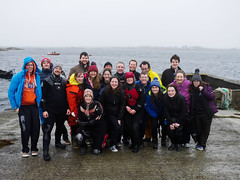his page outlines the course for the Advanced Diver grade. Advanced Diver is the fourth grade in the BS-AC diving grade sequence, and the next after Dive Leader. BS-AC consider the Advanced Diver grade to be equivalent to the CMAS three star diver level.
Definition
A diver who is comprehensively trained, experienced and responsible and can manage and supervise a wide range of adventurous and challenging diving. This will include organising diving expeditions to explore unknown locations and branch activities including dives utilising developing technology and techniques.
Training towards the Advanced Diver grade relies much more on the progressive build-up of experience than on ‘formal’ lessons.
While Advanced divers do not necessarily need to be qualified to use emerging technologies themselves, they need to have sufficient knowledge about them to safely incorporate them within branch diving.
The Advanced Diver course consists of:
- 4 Classroom lessons
- Theory assessment
- 2 Dry practical lessons
- 2 Open water lessons
- 20 dives post Dive Leader- (which may include open water lessons) minimum 600 minutes underwater time
Open water diving should encompass each of the following, each on at least three occasions:
- planned decompression dive – dive involving at least two planned decompression stops
- dive in tidal waters – dive involving a direct descent following a shot line, to dive on a specific site in a slack water window.
- drift dive – dive to a minimum depth of 15m in water moving at a speed which precludes a return to the point of entry.
In addition a further six dives should include at least three of the following:
- navigation dive – dive requiring navigation around a site.
- search dive – a dive involving the utilisation of underwater search techniques.
- no clear surface dive – a dive involving no clear surface, either cavern, wreck penetration or ice diving.
- mixed gas dive – a dive involving use of mixed gas, either closed circuit rebreather or open circuit.
- advanced decompression dive – a dive involving advanced decompression techniques and emergency gas deployment using decompression trapeze or lazy shot.
- surface location dive – a dive involving the surface location of an unknown site using surface searching techniques, followed by suitable precautions when diving an unknown site.
Of the 20 dives at least 10 should be carried out from boats, on at least 10 the student should act as dive leader and at least six dives should show experience of depths greater than 30m. On at least five occasions, including at both known and unfamiliar sites, the student should act as Dive Marshal.
Syllabus
| Lesson type | Code | Lesson title | Key components |
|---|---|---|---|
| Theory lessons | AT1 | The Role of the Advanced Diver | Senior diver and Dive Manager for unknown sites, charts, tides, weather |
| AT2 | Advanced Diving | Personal & equipment considerations, other diving gases/systems, developing own experience | |
| AT3 | Organising diving from different platforms | DM and organising, Cox’n/Skipper liaison, crewing on boats, ropework | |
| AT4 | Review of Diving Conditions & on-site first aid | ||
| Theory test | Multiple choice review of lecture course | ||
| Open water lessons | AO1 | Diving and Rescue skills | |
| AO2 | Rescue Management Review | ||
| Practical lessons | AP1 | Expedition Planning | |
| AP2 | Dive Managing | Planning & managing a dive at an unknown site | |
Instructors
Instruction for theory lesson AT1, and practical lessons AP1 and AP2 must be carried out by an Advanced Instructor or by an Assistant AI under on site supervision of an Advanced Instructor. For all other lessons, the instructor must be at least an Open Water Instructor and Advanced Diver.




